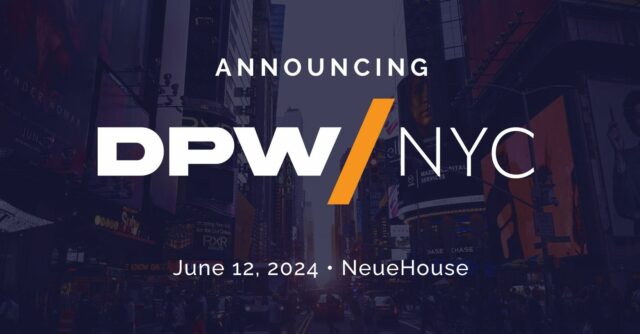John Rossman, managing partner at Rosman Partners, explores the concept of digital transformation and his book Think Like Amazon. With companies constantly referring to the Amazon effect, John calls upon his time working with Amazon to lay out 50 and a half ideas that businesses and organizations should consider as they look to transform their operations, embrace innovation, and enter the next era of business. By Dale Benton
Talk us through your career and your work with Amazon
In the 2000s, I had the opportunity to be a leader at Amazon. I got to launch the Marketplace business at Amazon so that’s third-party selling at Amazon.com. Today that’s 58% of all units shipped and sold are through that platform. And then I also ran the enterprise business where we ran other large retailers’ e-commerce infrastructure for them. That included target.com, ToysRUs, Marks & Spencer in the UK, and a number of other great brands. I left Amazon in late 2005 and got into consulting, where I started to see the impact of all the strategies and tools and approaches we took at Amazon to get the types of results we did. I started to use those with my clients. Several years after I left, one of my clients at the Bill and Melinda Gates Foundation came to me and said, “John, I’ve seen how you put the little anecdotes and manoeuvres from Amazon into our business. It’s very impactful. I think you ought to write a book about it.” That’s what really started me down the path of writing the books. So, today I do a number of keynote speaking and advisory work where I work with leadership teams over a long period of time as an advisor to their team, and help others figure out their digital strategy. That’s been my career arc.
We hear about the Amazon effect, but you’ve been on the inside of that, can you give us your perspective?
I mean I was there from early 2002 through to late 2005. It was a fascinating period at Amazon because that’s really when we started to develop the strategy of Amazon really being two types of businesses. One is a retailer, and the other is a platform company, and a platform company builds core capabilities that both Amazon and the retailer could use as well as third parties. So, we started to get super clear and work through our leadership principles, our approaches for how to operate as a platform company. It completely changed the way that I think about problem solving and about situations, and opportunities. I didn’t develop all of these techniques. I just paid attention in class, and it was really then through my repeated practice of inserting them into my client’s business at the appropriate point with the appropriate approach that really inspired me to write, Think Like Amazon, 50 and A Half Ideas To Become A Digital Leader. That was really my inspiration for the book; to pass on to others what all the little moves are that you can take from Amazon and put them into your business to help make change happen.
What does it mean to digitally transform? You’ve described it in your book as an introduction to mission impossible
I think part of the essence of being digital or digital transformation, is there are lots of good definitions. There’s no one right one. I believe that being digital is really the combination of two, what sounded like athletic attributes, but they’re really organisational attributes, which are speed and agility. So, if you think of what speed is, speed is about being able to do a repetitive motion extremely efficiently and extremely predictably. That’s really operational excellence, right? So on the one hand, being digital is about operational excellence in the relentless pursuit for driving out inefficiencies in the business, and for perfecting the customer experience. The other attribute of a digital organisation is agility, and agility is really the ability to both sense and make change happen, right? And that’s both small change and big change. So really, that’s the ability for an organisation to innovate within itself, right? So, it’s really that combination of speed and agility, operational excellence and systematic innovation that really makes a digital company. A lot of what I work with teams on, and speak to audiences about relates to being deliberate, right? In both your operational excellence and your innovation. Every leader would say that being innovative is critical to the success of their company going forward, but 95% actually don’t have a systematic approach for how that happens. It happens on an accidental or one-by-one basis. So much of the framing of this book and the ideas from Amazon are how to be planful and systematic in both your operational excellence and your innovation.
Is there a challenge of balancing the need to perform while transforming?
This isn’t about pausing what you’re doing now, but it really does set the basis. In fact, the first idea in the book is reset your clocks. Your journeys will not be a short or straight line. If I think about what’s the understated secret of Amazon’s success? Right? It’s a 25-year-old company now. There were the first 15 years of; it was struggling to survive and to make a name and a brand. It’s really just the past 10 years that this vortex of an organisation has come into being. So patience is, I think, an underlying and underappreciated skill set of leadership and management and boards. Amazon has forestalled and pushed out profitability in order to build the infrastructure, and to do these experiments, and to build their business, they’ve pushed out profitability. I think it is that addiction to quarterly profit results that creates the challenges in both being able to reinvent your business and deliver those quarterly results. Sometimes part of the journey is about reshaping how you’re taking profits and investing it into the business. You do have to invest in the business if you truly want to transform, and it’s not a predictable path, and it is certainly a long path. So, it’s almost irreconcilable to say, “I want to have fast transformation results,” right? Those things are almost irreconcilable. It’s oxymoronic in nature.
Is there still inherent risk averseness towards technology?
I think it’s actually because the technology is becoming simpler and easier to operate. Because the obvious need to innovate is becoming higher and everything, what’s being pushed to the forefront is a company’s capability of managing change. This gets to a big essence of the book, and in particular idea nine is called making the elephant dance: portfolio strategy and governance for innovation. It gets back to that observation which is most companies don’t have a deliberate systematic approach for innovation. This idea is just about one aspect of that systematic approach for innovation, which is about a portfolio strategy. A portfolio strategy just helps to understand and outline where are your investments going, and what type of risk versus return are you expecting across those. What most companies are good at is low risk, low reward types of projects and investments, right? Basically, if we execute well, we should have a return, but these are things that are not game changing types of endeavours. What most companies are not good at is the high risk, high reward types of investments, and this is really where you need to think big but bet small. You need to make these types of high risk, high reward investments as nimble and small and hypothesis-driven as possible. But just simply having a portfolio understanding of your investments is one key element for really understanding how am I making deliberate change in the organisation. And as your question tees up, technology is rarely the key challenge. The key challenge is in how we envision the future, how we run change initiatives in our organization, not just the technology component but the business model component, and the organizational change components to it, and the ecosystem and stakeholder management component to that. And those tend to be the things that get in the way of innovation.
With transformation comes a rebuilding of existing cultures and mindsets, what challenges does this present?
Idea number three is called move forward to get back to day one: change the culture of status quo. It really is about the essential awakening that leaders need, which is: are we playing offense? Are we about creating the future or are we about defence, and maintaining the status quo? Bezos frames this up by his quick little saying around we are a day one company. In one of his recent shareholder letters, he talks about what’s it mean to be a day one company versus a day two company? If you are a day two company, meaning you’re probably healthy, you’ve been around for a while, but you’re struggling with innovation and reinventing yourself, and you see some competitive threats coming from non-traditional competitors. He gives some advice relative to creating a day one culture, and some of that advice is about don’t manage through proxy. Proxy is those abstraction mechanisms that we put in place to help manage the business. Things like surveys and abstracted metrics. The key way to get away from that is understand the exact customer experience, have transactional metrics, and set a high bar relative to the perfect order, the perfect customer experience versus looking at it in an aggregate, and really about making sure that you’re dedicating time to work in the future. As a leadership team, we probably need to be more deliberate about working in the future. It’s amazing because people are not systematic about it. People and leaders hesitate to put time into actually working in the future. So, many of the ideas are about, ‘Whoa, what are the things I do to actually work in the future?’
What advice would you give to a company embarking on a digital transformation?
At the end of the day, it’s really about not the organisation transforming around me, but it’s about, well, what am I personally willing to do differently? What am I willing to learn? How am I willing to take on new practices, spend my time differently, prioritise my business results and my schedule, and my hiring practices too? What are you willing to do differently? What changes are you willing to take out of this and make happen as part of your personal habits?











